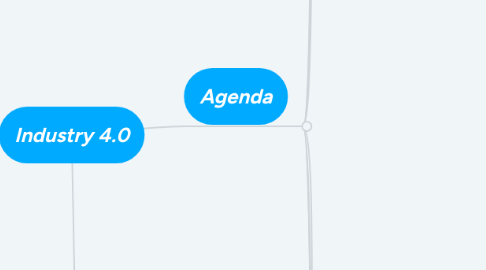
1. Agenda
1.1. Introduction to Industry 4.0
1.1.1. Why
1.1.1.1. The reasons why industry 4.0 is important are the benefits. It helps manufacturers with current challenges by becoming more flexible and reacting to changes in the market easier. It can increase the speed of innovation and is very consumer centered, leading to faster design processes.
1.1.1.1.1. Machines to reach place where humans cannot reach : Fire fighters Thailand football player Autonomous and Unbiased decisions Customization based on Individual needs
1.1.2. What
1.1.2.1. Industry 4.0 isn’t just about investing in new technology and tools to improve manufacturing efficiency—it’s about revolutionizing the way your entire business operates and grows. This session will provide you with an in-depth overview on the topic of Industry 4.0 and IIoT
1.1.2.1.1. Cyber-Physical Systems comprise smart machines, storage systems and production facilities capable of autonomously exchanging information, triggering actions and controlling each other independently.
1.1.3. How
1.1.3.1. Food and Beverage Industry (Content & Container & Label validation) Car Manufacturing (Depends on traffic in assemble line) Smart Home,City,World
1.2. Industry 4.0 - Timeline
1.2.1. Virtualization
1.2.1.1. a virtual copy of the Smart Factory which is created by linking sensor data (from monitoring physical processes) with virtual plant models and simulation models
1.3. Six Design Principles
1.3.1. Activity – Industry 4.0
1.3.1.1. Design your ideal example for Industry 4.0 ?
1.3.1.2. 4.0 indicates 4th revolution
1.3.1.2.1. First (1.0)- Steam machine (industry , automobile and locomotive) in 1765
1.3.1.2.2. Second (2.0) - Linear assembly system in 1865
1.3.1.2.3. Third( 3.0) – Process controls in 1969
1.3.1.2.4. Fourth (4.0)- Physical products and Intelligence of Data (Nowadays)
1.3.2. Interoperability
1.3.2.1. the ability of cyber-physical systems (i.e. work piece carriers, assembly stations and products), humans and Smart Factories to connect and communicate with each other via the Internet of Things and the Internet of Services
1.3.3. Decentralization
1.3.3.1. the ability of cyber-physical systems within Smart Factories to make decisions on their own
1.3.4. Real-Time Capability
1.3.4.1. the capability to collect and analyze data and provide the insights immediately
1.3.5. Service Orientation
1.3.5.1. Offering of services (of cyber-physical systems, humans and Smart Factories) via the Internet of Services
1.3.6. Modularization
1.3.6.1. Flexible adaptation of Smart Factories for changing requirements of individual modules
1.4. Nine Building Blocks
1.4.1. I_D_ST_ _ I_T_ _N_T of T_I_G_
1.4.1.1. Industry 4.0 means that more devices. This will allow field devices to communicate and interact both with one another and with more centralized controllers, as necessary. It will also decentralize analytics and decision making, enabling real-time responses.
1.4.2. A_T_F_C_A_ I_T_L_I_G_N_ _
1.4.2.1. With the help of machine learning, when maintenance is needed, it’s very focused – technicians are informed of the components that need inspection, repair and replacement; which tools to use, and which methods to follow.
1.4.3. B_G _ A_A
1.4.3.1. In an Industry 4.0 context, the collection and comprehensive evaluation of data from many different sources—production equipment and systems as well as enterprise- and customer-management systems—will become standard to support real-time decision making.
1.4.4. C_O_D C_M_U_I_G
1.4.4.1. More production-related undertakings will require increased data sharing across sites and company boundaries. As a result, machine data and functionality will increasingly be deployed to the C_O_D, enabling more data-driven services for production systems.
1.4.5. C_B_R S_C_R_T_
1.4.5.1. With the increased connectivity and use of standard communications protocols that come with Industry 4.0, the need to protect critical industrial systems and manufacturing lines from c_b_r s_c_r_t_ threats increases dramatically.
1.4.6. A_ _ IT_V_ _A_U_F_C_U_I_G
1.4.6.1. Companies have just begun to adopt a_ _ it_v_ _a_u_f_c_u_i_g, such as 3D printing, which they use mostly to prototype and produce individual components. With Industry 4.0, these a_ _ it_v_ _a_u_f_c_u_i_g methods will be widely used to produce small batches of customized products
1.4.7. A_T_N_M_US R_B_TS
1.4.7.1. R_b_ts will eventually interact with one another and work safely side by side with humans and learn from them. These R_b_ts will cost less and have a greater range of capabilities than those used in manufacturing today.
1.4.8. A_G_E_T_D R_A_I_Y
1.4.8.1. A_g_e_t_d R_a_i_y-based systems support a variety of services, such as selecting parts in a warehouse and sending repair instructions over mobile devices. A_g_e_t_d R_a_i_y in future is expected to provide workers with real-time information to improve decision making and work procedures.
1.4.9. S_M_L_T_ONS
1.4.9.1. S_m_l_t_ons will be used more extensively in plant operations to leverage real-time data and mirror the physical world in a virtual model, which can include machines, products, and humans. This will allow operators to test and optimize the machine settings for the next product
1.5. Benefits of Industry 4.0
1.5.1. Advantages of IR 4.0
1.5.1.1. Revenue Gains Increased Efficiency and productivity Machine Downtime Reductions Improved Supply / demand matching
1.5.2. Benefits of Industry 4.0 for you
1.5.2.1. Any Industry stream Any skills Anyone Can Achieve their dream!!
1.6. Q&A
1.7. End Minutes
1.7.1. Connect with Thiranvalar
1.7.2. Connect with me
2. Intro
2.1. Speaker
2.1.1. Lakshminarasimhan KR Network Architect , Team lead, 22 by Seven Pvt ltd, Bangalore Results driven and accomplished professional with over 12 years of quantifiable experience in network design & implementation, quality assurance, project management and performance evaluation.
2.1.1.1. MS (Software Engineering) from BITS Pilani .
2.1.1.1.1. Empowered aspirants in NGOs and fresher joining the company with Soft Skills , Motivation , Personality Development and Industry based sessions.
